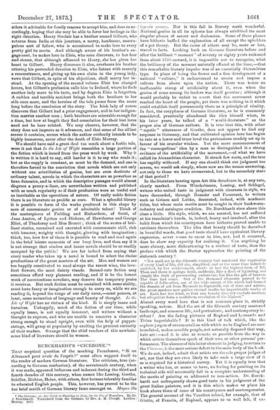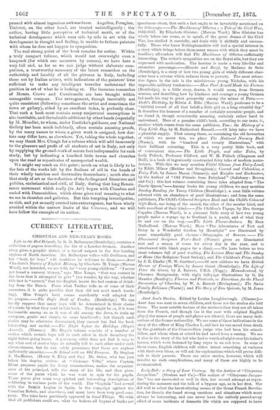BURCKHARDT'S "CICERONE."*
THAT sceptical question of the mocking Frenchman, "Si un Allemand pent avoir de l'esprit?" must often suggest itself to the reader of modern German literature. The criticism, true (ac- cording to German confession), of the seventeenth century, when it was made, appeared ludicrous and indecent during the third and fourth decades of this century, when names like Leasing, Goethe, Schiller, Richter, Heine, with others, first became tolerably familiar to educated English people. This, however, has proved to be the too brief zenith of German literary fame amongst us. Magna ilia • The CYeerone; or, Art Guide to Pointing in Italy, for the Use of Trarellera By Dr. .7. Burekhardt. Translated from the German, by Mrs. A. H. Clough. London: Murray. 1873.
in genie cessere. Nor is this fall in literary merit wonderful. National genius in all its spheres has always exhibited the most singular phases of ascent and declension. Some of these phases have hitherto baffled the explanation of all except the upholders of a pet theory. But the cause of others may be, more or less, traced to facts. Looking back on German literature before and after the brilliant " moment " of seventy or eighty years reckoned from about 1760 onward, it is impossible not to recognise, what the brilliancy of the moment naturally effaced at the time,—that this remarkable literary impulse was of an essentially Alexandrian type. In place of being the flower and a fine development of a national "culture," it endeavoured to create and impose a culture from above upon the nation. There was hence an ineffaceable stamp of artificiality about it, even when the genius of some among its leaders was itself genuine; although it would probably be unfair to msert that the movement never reached the heart of the people, yet there was nothing in it which could establish itself permanently there as a principle of vitality. In fact, the coryphmus of German literature, as he is commonly considered, practically abandoned the idea himself when, in his later years, he talked of a " world-literature" as the proper aim of German authors. It is true that this, with other " mystic " utterances of Goethe, does not appear to find any response in Germany, and that cultivated opinion here has begun to rate at a lower and truer level the pretensions crudely set up in favour of his oracular wisdom. Yet the mere announcement of the "cosmopolitan" idea by a man so distinguished is a strong evidence of the artificiality of the movement,—of what we have called its Alexandrian character. It struck few roots, and the tree has rapidly withered. If any one should think our judgment too severe, we would ask simply, where now are the names answering, not only to those we have enumerated, but to the secondary stars of that period ?
In the literature bearing upon Art this decadence is, at any rate, clearly marked. From Winekelmann, Leasing, and Schlegel, writers who united taste in judgment with clearness in style, we have descended, through Rumohr and Passavant, to writers such as Grimm and Lubke, decorated, indeed, with academic titles, but whose main merits must be sought in their bookworm- industry and catalogue erudition. Dr. Burckhardt rises above this class a little. His style, which, we are assured, has not suffered at his translator's hands, is, indeed, heavy and involved, after the habit from which his countrymen have hitherto proved unable to extricate themselves. The idea that beauty should be described in beautiful words, that good taste should have equivalent literary expression, never seems to occur to him, nor, had it occurred, does he show any capacity for realising it. Can anything be more clumsy, more disheartening to a student of taste, than the preface with which the Doctor approaches the painting of the sixteenth century ?
"Not until art in the fifteenth century had mastered the expression of every kind of life, did she, simplified, and at the same time infinitely enriched, by her achievement, create at last the highest form of life. Then and there it springs forth, suddenly, like a flash of lightning, not simply the fruit of persevering endeavour, but like the gift of heaven. The time had come. Out of the thousand elements proved to be capable of delineation, out of the wide extent of life which had formed the domain of art from Masaccio to Signorelli, out of time and nature, the great masters now gather eternal truths for imperishable works of art. Each has her kind, so that one beauty does not exclude another, but altogether form a multiform revelation of the highest."
Almost every word hero that is not common-place is, strictly speaking, untrue. Had the art of the fifteenth century mastered landscape, and common life, and portraiture, and contemporary in- cident? Are the fading pictures of Raphael and Leonardo and Titian imperishable ? It is this kind of talk which, like the copious jargon of ornamentalism with which we in England are now inundated, makes sensible people, not naturally disposed that way, hate art : —and it is also as remote as possible from the way in which artists themselves speak of their own or other persons' per- formances. The abseuceof this latter element in judging, to return to the Cicerone, is the most serious defect in the main body of the book. We do not, indeed, admit that artists are the sole proper judges of art, nor that they are even likely to take such a large view of it as is required for a historical survey. Yet it is equally true that a writer who has, or seems to have, no feeling for painting on its technical side will necessarily fail in a complete understanding of the merits of painting as addressed to non-artists. Dr. Burck- hardt not unfrequently shows good taste in his judgment of the great Italian painters, and it is this which makes us place his book above those of some of his countrymen and contemporaries. The general account of the Venetian school, for example, that of Giotto, of Francis., of Raphael, appears to us well felt, if ex- pressed with almost ingenious awkwardness. Angelico, Perugino, Tintoret, on the other hand, are treated unintelligently ; the author, having little perception of technical merit, or of the technical development which runs side by side in art with the development in thought and feeling, is unable to fathom painters with whom he does not happen to sympathise.
The real strong point of the book remains for notice. Within a truly compact volume, which would not overweight even a knapsack (for which one measures by ounces), we have here a very full and, as far as we can judge without elaborate com- parison, a trustworthy summary of the latest researches on the authorship and locality of all the pictures in Italy, including those not by Italian artists, with indications of the painters' lives sufficient to make any intelligent traveller understand the position in art of what he is looking at. The immense researches of Messrs. Crowe and Cavalcaselle are here brought within manageable compass. The arrangement, though inevitably not quite consistent (following sometimes the artist and sometimes the town or gallery), aided by an excellent index, is perfectly clear. That such a book must contain many conjectural assumptions is also inevitable, and the valuable additions by other hands (especially by M. Miindler, to whom, under Eastlake's guidance, our National Gallery has been much indebted), often contain amusing proofs, by the many names to whom a given work is assigned, how doc- tors may differ here, as elsewhere. Yet, taking the whole together, we may thank Mrs. Clough for a volume which will add immensely to the pleasure and profit of all students of art in Italy, not only by supplying the ground-work of secure fact indispensable for such study, but by indicating a hundred little towns and churches upon the road as repositories of unsuspected wealth.
We might say much on this point.; much on what is likely to be the fate of the works left by the Italians of old in the hands of their wholly tasteless and destructive descendants ; much also on that study of art as the reflection of the feelings and literature and politics, ecclesiastical and civil, of Italy, during that long Renais- sance movement which really (in Art) began with Chnalme and ended with Domenichiuo, which alone gives real meaning to what we see in churches and galleries. But this tempting investigation, so rich, and yet so easily carried into extravagance, has been wisely avoided within the narrow limits of the Cicerone, and we will here follow the example of its author.



































 Previous page
Previous page